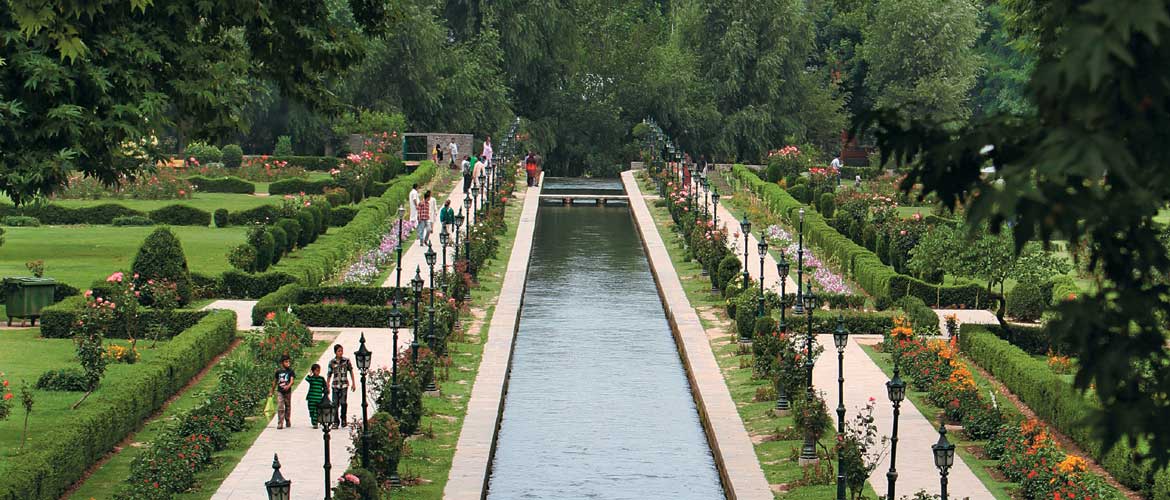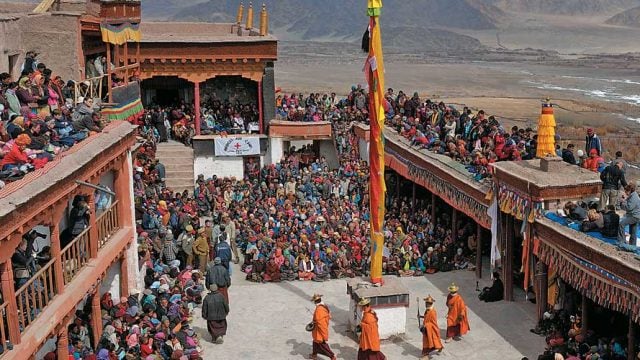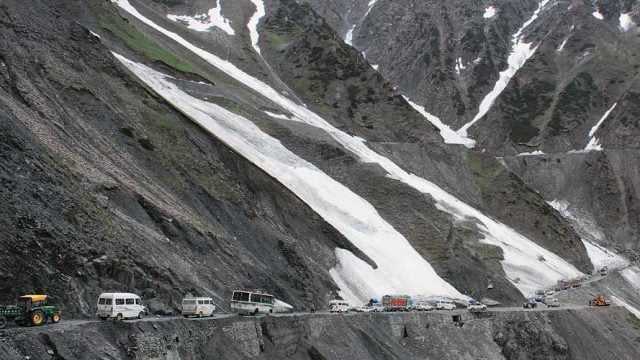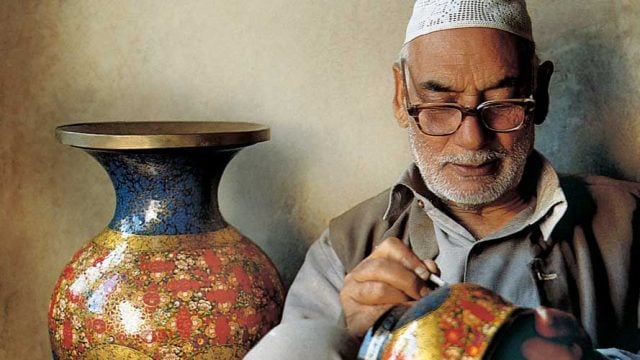Many summers ago, on my first visit to Srinagar, I travelled by road from
Verinag is, however, more than just a beautiful valley and, for road travellers, it is the first view of Kashmir. It is home to a spring, revered for ages, that is the source of the principal river of the Vale of Kashmir, River Jhelum. The Mughal Emperor Jehangir had come to Verinag, became enchanted and built a pool, a pavilion and a garden around this spring. His son, Shah Jehan, enlarged the garden and added baradaris and hammams, most of which have perished over time.

If you decide to stay at Verinag, from your perch at the JKTDC’s Alpine Resort, backed by a forested mountain, you get to see a bird’s eye view of this Mughal creation — the pavilion, a channel carrying the spring water through a garden, trees, enormously big chinars, people lolling about or strolling through all of this, the town beyond, and the hills still behind it… You can spend a good amount of time just letting this seep into your consciousness as the sun travels and the skies change their colours, finally pulling on a blanket of dark and putting everyone to sleep.
THINGS TO SEE AND DO
Mughal Garden
Verinag Garden sits a little above the town, built on a spur of the mountain under which the Verinag spring is born. A large, deep tank surrounds the spring such that the water on its surface appears completely calm. It is said that the spring emerges at a depth of 54 ft. Around the tank is an arcade, octagonal in shape, with a broad walkway and recesses in its walls. On the walls are two Persian inscriptions on stone slabs. One is by Jehangir (“Padshah…Noor-ud-din, Jehangir…”), announcing the year of its construction as 1619-1620, and other one by Shah Jehan saying that the aqueduct was built in 1626-1627.
TIP Ask around to find the lone guide here and he can recite the inscriptions for you. There’s no guide fee, and you can tip as you like
In two of the recesses of the pavilion, there are Hindu icons, one of them a Shivaling. Some people claim that these predate the Mughal construction, but it is more likely that they date from the Dogra period (1870s) when this and many other gardens in Kashmir were repaired.

The tank here has a lot of fish and water flows out from it into a channel around which are the lawns with flowers and trees. On the eastern side of the garden, there’s another, smaller spring. Check out the cluster of three chinars that form a lovely umbrella over this one. It is very soothing to walk along the water channel in the garden, sit on a bench or under a tree and watch others doing the same.
The garden has three entrances: one below the JKTDC’s Alpine Resort (this is to the west), the second on the other side of the tank (east) and the third at the far end of the garden (north), after which the water goes out to join other streams and give rise to the Jhelum. The main town of Verinag is towards the north. At the north entrance is a mini bazaar, with shops selling snacks and trinkets.
Entry fee ₹10
Vyatastha
About 2 km from the centre of Verinag, on NH1A back to Qazigund, Vyatastha is another spring with a small park around it. Village women do their washing here, while children play. It is a pleasant walk to Vyatastha through houses and fields. Interestingly, Vitasta is said to be an ancient name for Jhelum River (also called Jehlum and Vyeth). Autos charge ₹ 100 for a return journey.
Walk to Jawahar Tunnel
You can walk up to the famous Jawahar Tunnel. The route is a motorable road, which joins the Jammu-Srinagar Highway NH1A. It goes through Omoh Village, which has the ruins of an old, presumably Mughal period caravanserai called Mughal Sarai. On the path till Omoh, the landscape feels like an extension of Verinag, but beyond Omoh it becomes more mountain village-like, with some patches of forest. Just before the highway, you get lovely views of the Verinag Valley surrounded by hills.
TIP There are a lot of security checks near the Jawahar Tunnel; you might want to walk back before reaching them

WHERE TO STAY AND EAT
JKTDC’s Alpine Resort (Mobile: 09419166212; Tariff: ₹ 600-800) is beautifully located high up from the Mughal Garden, yielding great views. The hotel and its 6 double rooms have been revived this year after many years of a lull in visitor arrivals. There’s a kitchen which will dish out basic north Indian fare. Just below the hotel is a JKTDC restaurant which also cooks food that is none too different.
AROUND VERINAG
Achabal (22 km)
Kokernag (20 km)
Crossing Banihal
‘Banihal’ means blizzard in Kashmiri. It is the name of the pass, at above 9,000 ft in the Pir Panjal mountain range which separates the Kashmir Valley from the Jammu region, that had to be crossed to reach Kashmir from the north Indian plains. The only other route, easier and more used from the plains, was the Jhelum Valley Road which ran through what is now Pakistan, and which was closed after Partition. However, Banihal Pass was accessible only in summer and remained snowed under in winter. Therefore, the Kashmir Valley experienced a host of shortages after partition. To have a round-the- year connection with Kashmir, the 2½- km-long Jawahar Tunnel was built in the 1950s, at about 7,000 ft through the Pir Panjal Range. This opened out on the Kashmir side just above Verinag. Now, a new tunnel, almost 4 times longer at 8 km and at a lower altitude (below 6,000 ft), is near completion. Also, an 11-km-long rail tunnel has been added this year by the newly built Kashmir Railway to connect Qazigund with Banihal, also the name of the town below the Banihal Pass in Ramban District.
FAST FACTS
When to go April to November is the main season. December-January offers snow but there’s not much infrastructure in Verinag for winter
Tourist Offices, J&K Tourism, Tourism Hut, Near JKTDC’s Alpine Resort, Verinag, Mobile: 09622808234, Website: jktourism.org
Verinag Development Authority, Chief Executive Officer, Verinag, Tel: 01932-291645, Mobile: 09419023449, STD code 01932
GETTING THERE
Location Verinag, chief source of the Jhelum River, is in a small valley at 6,108 ft, surrounded by hills in Anantnag District, with the Pir Panjal Range rising to the south west
Distances 83 km SE of Srinagar, 26 km S of Anantnag JOURNEY TIME By Road 2 hrs
Route1 from Srinagar NH1A to Khanabal via Pampore and Avantipora; state roads to Verinag via Anantnag, Larkipora and Doru
Route2 from Srinagar NH1A to Qazigund via Pampore, Avantipora and Khanabal; state road to Verinag
Air Nearest airport: Sheikh-ul-Alam Airport, Srinagar (87 km/2½ hrs/ Tel: 0194-2303000/ 31), connected to Delhi, Mumbai, Leh and Jammu by Air India, SpiceJet, Indigo, Go Air. Pre-paid taxis charge ₹2,000 to Verinag, one-way
Rail Nearest railhead: Jammu Tawi (219 km/6 hrs). Taxi charges ₹4,500-5,000 to Verinag. When driving up from Jammu along the Srinagar Highway (NH1A), Verinag is just 4 km from Jawahar Tunnel; look for a road going down on the right about 1 km after the tunnel
Road From Srinagar, follow the Srinagar- Jammu NH1A past Pampore, Avantipora and over the Sangam bridge till Khanabal. A short way into Khanabal is the Degree College to the left. Here, NH1A turns right to Jammu; the road continuing straight is NH1B. Follow NH1B through Anantnag. A kilometre ahead, just across Khanabal Bridge, NH1B too turns right. Take the right and follow NH1B through Anantnag for about 2 km, till the crossing between the TB Hospital and Afzal Beg Hospital, where you turn right onto the Verinag Road. About 6 km down the road is Hardialgam, just ahead of which the road forks. The right fork is the Verinag Road. Continue along the road past Larkipora, Doru and across the Jhelum to Verinag. From Srinagar, you could also continue south on NH1A from Khanabal to Qazigund and 7 km later, before Jawahar Tunnel, is the left turn for Verinag, 4 km away. The NH1A route is longer by just 4 km. Taxi charges ₹2,000 for a drop from Srinagar. Shared taxis/ Sumos (₹70) run from TRC Srinagar all through the day for Anantnag, from where you can promptly get shared taxis to Verinag (₹35). Private buses also serve this route
Kashmir
Verinag
India





